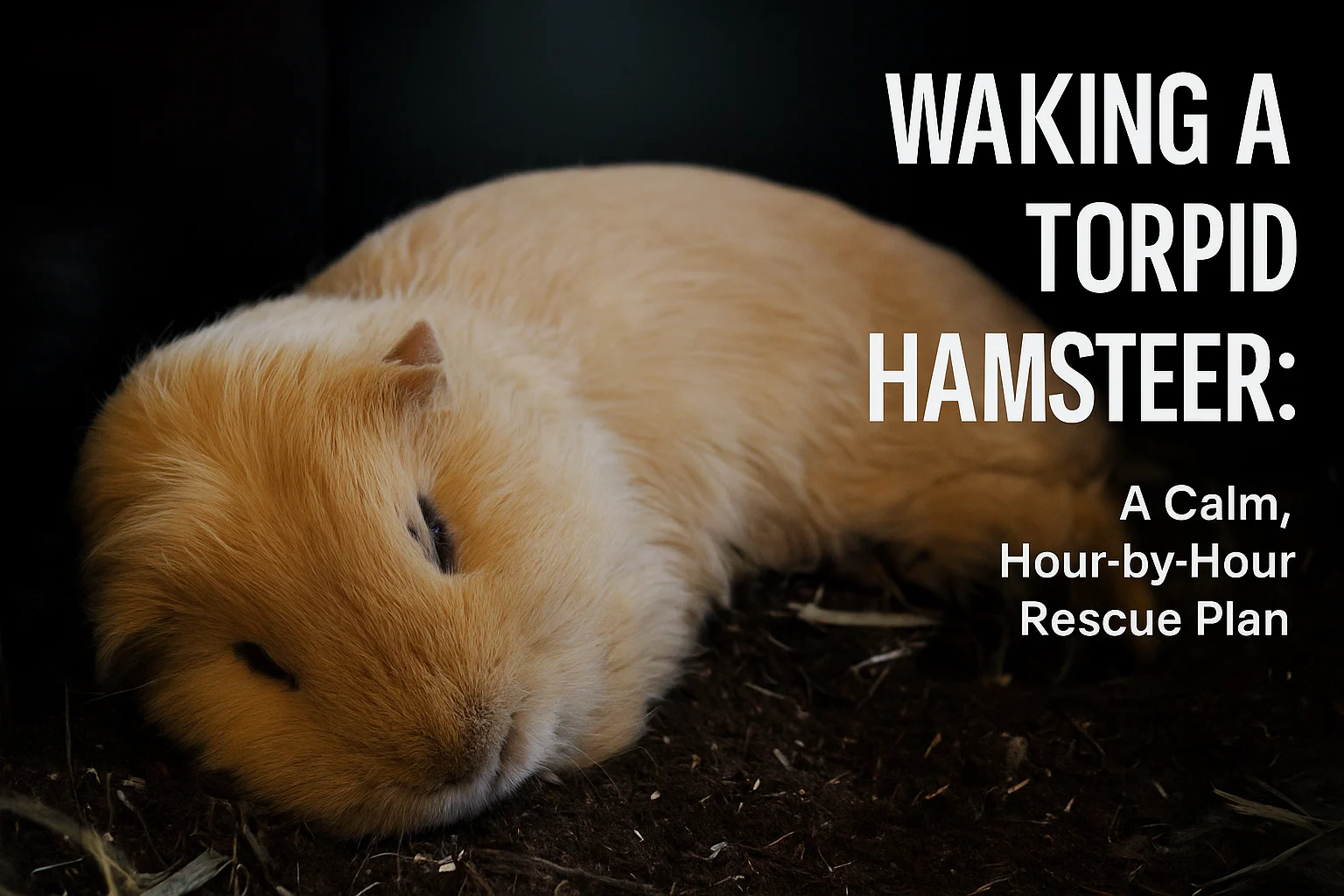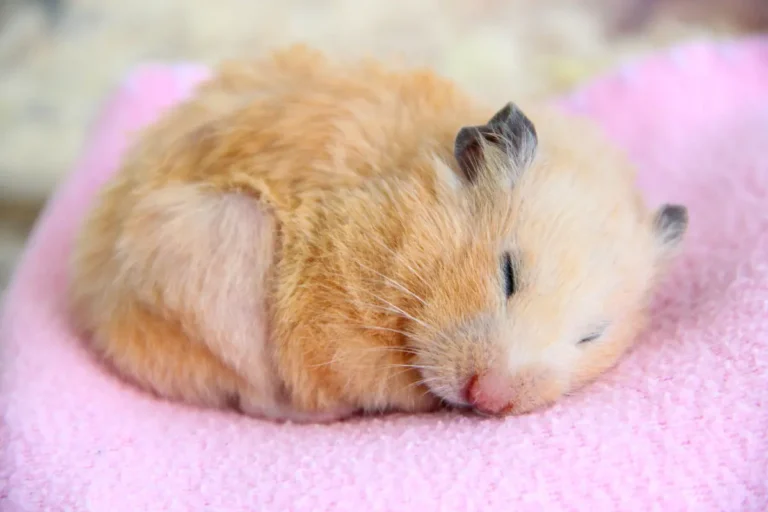Waking a Torpid Hamster: A Calm, Hour-by-Hour Rescue Plan
Finding your hamster cold, limp, and unresponsive is every owner’s nightmare. But before you assume the worst, it’s crucial to know that your pet might not be gone—just in torpor.
Torpor is a temporary survival state triggered by environmental stress, most often cold. While it looks eerily like death, it’s reversible with the right care and a calm, steady approach. This guide walks you through everything you need—from tools to an hour-by-hour rescue plan—to give your hamster the best chance of recovery.
What You’ll Need Before You Start
Gather these supplies before attempting to revive a torpid hamster. Having everything ready reduces panic and ensures a smoother recovery process.
✔️ Digital room thermometer
Confirms that your hamster’s environment is warm enough to support revival. Aim for a steady 70–75°F (21–24°C). If the room is too cold, relocate the enclosure before beginning.
✔️ Small fleece or soft hand towel
Used to gently wrap your hamster during warming. Fleece insulates well without overheating and acts as a safe barrier between the hamster and any heat source.
✔️ Body-safe heat source
Your own body heat is ideal—cupped hands or holding the wrapped hamster against your chest. Alternatively, use a warm (not hot) water bottle wrapped in a towel.
⚠️ Never use heating pads directly, heat lamps, or place the hamster in deep bedding above a heated mat. These can cause burns or thermal shock.
✔️ 1 ml needle-less syringe or small paintbrush
For offering tiny amounts of warm sugar solution once your hamster begins to stir. Only use once the swallowing reflex returns.
✔️ Sugar solution
Mix 1 tsp of honey or plain sugar into 2 tsp of warm water (under 104°F/40°C). This provides a vital glucose boost as the metabolism restarts.
✔️ Stopwatch or phone timer
Helps you time observation windows, sugar doses, and warming periods—ensuring you stay on track without rushing or overdoing it.
⚠️ Safety Tip: Never try to “jump-start” a torpid hamster with extreme heat (lamps, hair dryers, or hot water immersion). Sudden temperature spikes can damage internal organs and shock the circulatory system.
Hour-by-Hour Rescue Timeline
Hour 0 (Minutes 0–10): Confirm & Stabilize
This is the most critical moment. Stay calm, move gently, and focus on three goals: confirm torpor, remove stress, and begin safe warming.
✅ Step 1: Check the environment.
If the room is below 65°F (18°C), immediately move the entire cage—bedding and all—to a warmer, draft-free space. The ideal recovery zone is 72–75°F (22–24°C).
✅ Step 2: Look for signs of life.
Torpor mimics death, but there are clues: the hamster will be limp (not stiff), whiskers may twitch under light, and you may spot one breath every 30–60 seconds. If you have a stethoscope, listen for a faint heartbeat.
✅ Step 3: Handle with care.
Scoop your hamster gently—along with surrounding bedding—into a fleece wrap. Keep the body level and loosely bundled to trap warmth without restricting movement or airflow.
Hour 0–1: Gradual Warm-Up & Sugar Boost
Now that your hamster is stabilized in a warm space, focus on gentle rewarming and supporting circulation.mingand introducing a gentle glucose boost to restart the metabolism.
Minutes 10–30: Use your body heat
Hold the wrapped hamster against your torso or under your shirt. Your body heat (~98°F/37°C) offers a safe and natural warming method.
Massage the back and flanks every 5 minutes to encourage blood flow and internal wake-up cues.
Minutes 30–60: Begin sugar rehydration
If your hamster shows twitching, jaw movement, or shifting posture, it’s time for a sugar boost.
Prepare the sugar solution and use a small syringe or paintbrush to drip a drop or two onto the incisors or lower lip every 2–3 minutes, letting excess dribble away. Aim for 0.5–1 ml total during this time.
Hour 1–2: First Stirring & Deeper Warm-Up
If signs of life are increasing, it’s time to transition to a controlled warming environment and offer energy-rich food.
✅ Set up a recovery bin
Move your hamster into a pre-warmed hospital carrier or small bin, with a heating pad under half and layers of towels to avoid overheating. Maintain ambient temperature around 75°F (24°C).
✅ Offer soft, high-energy food
At this stage, chewing hard pellets is usually too difficult. Instead, provide 1 teaspoon of warm, mushy food such as:
- Plain baby rice cereal (unsweetened and onion-free)
- Soaked pellet mash
- Unflavored oatmeal or wheat cereal
Gently place the food near your hamster’s mouth—but let it eat on its own terms. Don’t attempt to force-feed.
✅ Continue sugar drops if swallowing is active
If your hamster is swallowing reliably, offer one or two sugar-solution drops every 10 minutes, as before.
Hour 2–4: Monitoring & Small Meals
Recovery should now be more visible. Movements become purposeful—licking paws, grooming, or shifting position.
💧 Transition from sugar to plain water
Once swallowing is consistent, offer lukewarm water with a clean syringe or cotton swab. Hydration now takes priority.
🍗 Introduce protein-rich soft foods
Offer small portions of easily digestible, protein-heavy snacks to rebuild energy reserves. Suitable options include:
- A tiny piece of plain scrambled egg (no oil or salt)
- A sliver of cooked, unseasoned chicken
- Soaked pellets or soft cereal mash in a clean, low dish (a bottle cap works well)
Let your hamster nibble at its own pace—forcing food can cause aspiration or stress.
🌙 Keep the environment quiet and dim
Stress is still a major risk. Maintain a low-light, low-noise setting, free of sudden movement or loud voices. A startled hamster in recovery may regress or panic, which can trigger health setbacks.
Your hamster may fall asleep again—but this time, it’s normal rest, not torpor. Monitor from a distance and continue providing gentle warmth and hydration for the next few hours.
Hour 4–8: Back to the Main Habitat (With Safeguards)
If your hamster is warm, mobile, and alert, it can return to its regular cage—with a few precautions.
- Transfer gently
Place your hamster (and some warmed nesting material) into a cleaned cage in a stable 72–75°F room. Avoid placing it on cold surfaces. - Add nesting depth
Provide 3–4 inches (8–10 cm) of soft bedding like shredded paper or fleece strips. This allows self-regulation of warmth and prevents re-entry into torpor overnight. - Remove the wheel temporarily
Muscles may still be weak. Leave the exercise wheel out to avoid injury or exhaustion. - Monitor every 30 minutes
Check for breathing, posture, and drinking. If the bottle isn’t used yet, offer water drops on your fingertip or a spoon.
Hour 8–24: Vet Watch Window
Even after waking, torpor can mask serious complications. Watch closely, and contact an exotics vet if you notice:
🚫 Labored breathing or audible clicks
Any wheezing, gasping, or clicking sounds could indicate pneumonia or fluid buildup in the lungs—a known post-torpor risk.
🚫 Persistent wobbliness after 12 hours
If your hamster still staggers, falls over, or seems disoriented more than half a day after waking, this could point to neurological effects, inner ear issues, or a lingering metabolic imbalance.
🚫 Refusal to drink or urinate within 18 hours
A revived hamster should be hydrating regularly. Lack of drinking or dry bedding can signal dehydration or kidney distress—both medical emergencies.
🚫 Dark red or blackened extremities
If feet, toes, ears, or tail appear unusually dark or shriveled, your hamster may have suffered frostbite during torpor. This requires prompt treatment to prevent tissue death and infection.
Quick-Glance “Red Flag” Checklist
| Sign | Act Within… | Why It Matters |
|---|---|---|
| No chest movement after 2 full minutes | Immediately | Could indicate death rather than torpor; warming will not help. |
| Body temperature rises above 99°F (37°C) | Instantly | Overheating can cause internal organ damage during revival. |
| Green or blood-tinged discharge from nose/mouth | 1 hour | May signal a respiratory infection worsened by torpor. |
| Torpor lasts >24 hours despite 75°F environment | 24 hours | Organ damage is increasingly likely—requires vet intervention. |
When in doubt, don’t wait. It’s far safer to let a vet rule out complications than to assume recovery is complete. Torpor is a stress test on the body—and not every hamster passes it without help.
After-Care Essentials
- Stable climate: 65-75 °F room, thermometer on the wall, no windows ajar.
- Light discipline: minimum 12 h light daily in winter to suppress the “short-day” hormone melatonin.
- Never run out of food or water: even one night of empties can retrigger the energy-crisis switch.
- Deep bedding: 6 in / 15 cm lets the hamster build a warm burrow.
- Extra vigilance: once a hamster has torpored, its threshold is lower—spot-check temps and behavior every evening for the next week.
Torpor may look like the end—but it’s often just your hamster’s way of buying time in a crisis. With a warm room, gentle hands, and a little sugar and patience, many hamsters make a full recovery within hours.
(Information compiled from community veterinary guidance and rescue protocols.)
Source: thehamsterforum, justanswer, woodgreen






